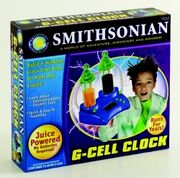Potatoes and juice as biofuels[]
Potatoes and acidic juices can produce electricity. Potatoes produce electricity when the salt in the potato mixes with the water in the potato and releases some ions, a positively charged sodium ion and a negatively charged chlorine ion. When two different metals are put into the potato, say copper and zinc, the ions are attracted to the metal that reacts to the charge opposite of itself, since opposite charges attract each other. The metal then becomes charged. Acidic juice produces electricity when a piece of zinc and a piece of copper are put inside and the acid oxidizes the zinc, releasing electrons. The electrons are then carried by electrolytes to the copper. If wires are connected to the metals on the potato or juice, they will work in the same way as a battery with + and - sides and be able to power something.

How can we use potatoes and juice?[]
One or more potato/juice batteries (potatoes or juice with the metals) can power anything that runs on electricity.
How they're used today[]
Smithsonian has released a potato clock and a juice clock (see pictures). Other corporations have done the same, but this is about the limit of commercial use of potatoes and juice.


Disadvantages[]
Though they produce no pollution, the potato and acidc fruit must still be grown and harvested. Also, it takes two potatoes to power a digital clock. Potatoes also rot and juice evaporates.